Phlogopite 40Ar/39Ar Geochronology for Guodian Skarn Fe Deposit in Qihe–Yucheng District, Luxi Block, North China Craton: A Link between Craton Destruction and Fe Mineralization
Abstract
:1. Introduction
2. Geological Background
3. Ore Deposit Geology
4. Sampling and Analytical Methods
5. Test Results
6. Discussion
6.1. Metallogenic Geological Characteristics
6.2. Age of the Guodian Fe Deposit
6.3. A Causal Link between Iron Skarn Mineralization and Craton Destruction
| Mining Area | Intrusion/Deposit | Number | Sample | Analytical Method | Age (Ma) | References |
|---|---|---|---|---|---|---|
| Qihe-yucheng | Guodian iron deposit | 1 | Phlogopite-bearing iron ores | Phlogopite 40Ar-39Ar Dating | 131.64 ± 1.69 | This study |
| Guodian intrusions | 2 | Diorite | Zircon U-Pb dating | 124.4 ± 1.4 | [8] | |
| Litun intrusions | 3 | Diorite | Zircon U-Pb dating | 130 ± 2.3 | [26] | |
| Dazhang intrusions | 4 | Diorite | Zircon U-Pb dating | 131.6 ± 1.7 | ||
| Ji’nan | Zhangmatun intrusions | 5 | Gabbro | Zircon U-Pb dating | 130.2 ± 1.8 | [57] |
| Zibo | Zhaokou iron deposit | 6 | Garnet skarn | Garnet U-Pb dating | 128 ± 3 | [5] |
| Jinling intrusions | 7 | Biotite diorite | Zircon U-Pb dating | 127.9 ± 1.4 | [56] | |
| Laiwu | Zhangjiawa iron deposit (I) | 8 | Skarn | Sphene U-Pb dating | 131 ± 3.9 | [4] |
| 9 | Phlogopite-bearing iron ores | Phlogopite 40Ar-39Ar Dating | 129.7 ± 0.8 | [5] | ||
| Zhangjiawa iron deposit (Gangli) | 10 | Phlogopite-bearing iron ores | Phlogopite 40Ar-39Ar Dating | 131.5 ± 1.2 | ||
| Kuangshan intrusions | 11 | Diorite | Zircon U-Pb dating | 130 ± 1 | [4] | |
| Jiaoyu intrusions | 12 | Diorite | Zircon U-Pb dating | 131 ± 1 | [55] | |
| Jinniushan intrusions | 13 | Diorite | Zircon U-Pb dating | 130 ± 1 | ||
| Tietonggou intrusions | 14 | Pyroxene diorite | Zircon U-Pb dating | 133 ± 2 | [56] |
7. Conclusions
Author Contributions
Funding
Data Availability Statement
Acknowledgments
Conflicts of Interest
References
- Zhang, Z.C.; Li, H.M.; Li, J.W.; Song, X.Y.; Hu, H.; Li, L.F.; Chai, F.M.; Hou, T.; Xu, D.R. Geological settings and metallogenesis of high-grade iron deposits in China. Sci. China Earth Sci. 2021, 64, 691–715. [Google Scholar] [CrossRef]
- Zhang, Z.C.; Hou, T.; Li, H.M.; Li, J.W.; Zhang, Z.H.; Song, X.Y. Enrichment mechanism of iron in magmatichydrothermal system. Acta Petrol. Sin. 2014, 30, 1189–1204. [Google Scholar]
- Deng, X.D.; Li, J.W.; Wen, G. U-Pb Geochronology of Hydrothermal Zircons from the Early Cretaceous Iron Skarn Deposits in the Handan-Xingtai District, North China Craton. Econ. Geol. 2015, 110, 2159–2180. [Google Scholar] [CrossRef]
- Duan, Z.; Li, J.W. Zircon and titanite U-Pb dating of the Zhangjiawa iron skarn deposit, Luxi district, North China Craton:implications for a craton-wide iron skarn mineralization. Ore Geol. Rev. 2017, 89, 309–323. [Google Scholar] [CrossRef]
- Duan, Z.; Gao, M.B.; Gao, J.L.; Li, C.J.; Feng, Q.W.; Li, S.Y.; Gao, W.S.; Wang, X.Z.; Xu, Z.Y.; Li, J.W. Phlogopite 40Ar/39Ar dating of the Zhangjiawa iron deposit, Laiwu district, Shandong Province: Implications for regional iron skarn mineralization of North China Craton. Acta Geol. Sin. 2022, 96, 1279–1296. [Google Scholar] [CrossRef]
- Zheng, J.M.; Xie, G.Q.; Liu, J.; Chen, M.H.; Wang, S.M.; Guo, S.F.; Gao, X.; Li, G.D. 40Ar/39Ar dating of phlogopite from the Xishimen skarn deposit in the Handan Xingtai area, southern Hebei, and its implications. Acta Petrol. Sin. 2007, 23, 2513–2518. [Google Scholar] [CrossRef]
- Shen, J.; Li, S.; Santosh, M.; Dong, G.; Wang, Y.; Liu, H.; Peng, Z.; Zhang, Z. Zircon U-Pb geochronology of the basement rocks and dioritic intrusion associated with the Fushan skarn iron deposit, southern Taihang Mountains, China. J. Asian Earth Sci. 2015, 113, 1132–1142. [Google Scholar] [CrossRef]
- Qin, J.; Zhu, X.Q.; Wang, L.J.; Hao, X.Z. Ore-forming Origin of Rock Mass Zircon U-Pb Chronology and Geochemical Evidence of Pandian Iron Deposit in Luxi Area. Shandong Land. Resour. 2023, 39, 14–22. [Google Scholar] [CrossRef]
- Griffin, W.L.; Zhang, A.D.; O’reilly, S.Y.; Ryan, C.G. Phanerozoic evolution of the lithosphere beneath the Sino-Korean craton. In Mantle Dynamics and Plate Interactions in East Asia, 1st ed.; Flower, M.F.J., Chung, S.L., Lo, C.H., Lee, T.Y., Eds.; American Geophysical Union: Washington, DA, USA, 1998; Volume 27, pp. 107–126. [Google Scholar]
- Fan, W.M.; Zhang, H.F.; Baker, J.; Jarvis, K.E.; Mason, P.R.D.; Menzies, M.A. On and off the North China Craton: Where is the Archaean keel? J. Petrol. 2000, 41, 933–950. [Google Scholar] [CrossRef]
- Gao, S.; Rudnick, R.L.; Yuan, H.L.; Liu, X.M.; Liu, Y.S.; Xu, W.L.; Ling, W.L.; Ayers, J.; Wang, X.C.; Wang, Q.H. Recycling lower continental crust in the North China craton. Nature 2004, 432, 892–897. [Google Scholar] [CrossRef]
- Kusky, T.M.; Windley, B.F.; Zhai, M.G. Tectonic evolution of the North China Block:from orogen to craton to orogen. Geol. Soc. 2007, 280, 1–34. [Google Scholar] [CrossRef]
- Menzies, M.; Xu, Y.G.; Zhang, H.F.; Fan, W.M. Integration of geology, geophysics and geochemistry: A key to understanding the North China Craton. Lithos 2007, 96, 1–21. [Google Scholar] [CrossRef]
- Gao, S.; Zhang, J.F.; Xu, W.L.; Liu, Y.S. Delamination and destruction of the North China Craton. Chin. Sci. Bull. 2009, 54, 3367. [Google Scholar] [CrossRef]
- Wilde, S.A.; Zhou, X.; Nemchin, A.A.; Sun, M. Mesozoic crust-mantle interaction beneath the North China craton: A consequence of the dispersal of Gondwanaland and accretion of Asia. Geology 2003, 31, 817–820. [Google Scholar] [CrossRef]
- Wu, F.Y.; Walker, R.J.; Yang, Y.H.; Yuan, H.L.; Yang, J.H. The chemical-temporal evolution of lithospheric mantle underlying the North China Craton. Geochim. Et Cosmochim. Acta 2006, 70, 5013–5034. [Google Scholar] [CrossRef]
- Zhai, M.G.; Bian, A.G.; Zhao, T.P. The amalgamation of the supercontinent of North China Craton at the end of Neo-Archaean and its breakup during late Palaeoproterozoic and Meso-Proterozoic Science in China series D. Earth Sci. 2000, 43, 219–232. (In Chinese) [Google Scholar] [CrossRef]
- Zhu, R.X.; Chen, L.; Wu, F.Y.; Liu, J.L. Timing, scale and mechanism of the destruction of the North China Craton. Sci. China Earth Sci. 2011, 54, 789–797. [Google Scholar] [CrossRef]
- Xu, W.L.; Wang, D.Y.; Wang, Q.H.; Pei, F.P.; Lin, J.Q. 40Ar/39Ar dating of hornblende and biotite in Mesozoic intrusive complex from the North China Block: Constraints on the time of lithospheric thinning. Geochimica 2004, 33, 221–231. [Google Scholar] [CrossRef]
- Yang, C.H.; Xu, W.L.; Yang, D.B.; Liu, C.C.; Liu, X.M.; Hu, Z.C. Petrogenesis of the Mesozoic High-Mg Diorites in West Shandong: Evidence from Chronology and Petro-geochemistry. Earth Sci.-J. China Univ. Geosci. 2006, 31, 81–92. [Google Scholar]
- Zhu, R.X.; Xu, Y.G.; Zhu, G.; Zhang, H.F.; Xia, Q.K.; Zheng, T.Y. Destruction of the North China Craton. Sci. China Earth Sci. 2012, 55, 1565–1587. [Google Scholar] [CrossRef]
- Duan, Z. The Mineralization and Mechanism of the Iron Skarn Deposits in Laiwu District, Shandong Province. Doctoral Thesis, China University of Geosciences (Wuhan), Wuhan, China, 2019. [Google Scholar]
- Hao, X.Z.; Zheng, J.M.; Liu, W.; Wang, R.S.; Wang, Q.Y.; Zhang, G.L. Metallogenic Prognosis of Skarn-type Iron Ore Deposits in Qihe–Yucheng Area, Shandong Province. Acta Geosci. Sin. 2020, 41, 293–302. [Google Scholar] [CrossRef]
- Hao, X.Z.; Zhang, G.L.; Liu, W.; Wang, R.S.; Li, Y.P.; Zhi, Y.B.; Wang, J.G. Prospecting methods of skarn type iron deposit in Dezhou area, Shandong Province. Miner. Explor. 2020, 11, 1219–1227. [Google Scholar]
- Wang, R.S.; Hao, X.Z.; Chen, D.L.; Chen, H.J.; Liu, H.B.; Wang, H.J.; Yu, L.; Li, R.; Liu, H.; Liu, W. Discussion on the boundary of metallogenic geological body of skarn type iron deposits and study on its deep characteristics in Qihe-Yucheng area, Sshandong Province. Prog. Geophys. 2022, 37, 59–68. [Google Scholar] [CrossRef]
- Hao, X.Z.; Guo, Y.M.; Li, Y.P.; Wang, J.G.; Zhang, C.C.; Wang, Q.Y.; Liu, B.B.; Zhi, Y.B. Metallogeny of the skarn-type iron deposits in Qihe-Yucheng ore district, Shandong Province. J. Geol. 2019, 43, 566–572. [Google Scholar] [CrossRef]
- Liu, S.; Hu, R.Z.; Gao, S.; Feng, C.X.; Qi, L.; Zhong, Z.; Xiao, T.; Qi, Y.Q.; Wang, T.; Coulson, I.M. Zircon U-Pb geochronology and major, traceelemental and Sr-Nd-Pb isotopic geochemistry of mafic dykes inwestern Shandong Province, East China: Constrains on their petro-genesis and geodynamic significance. Chem. Geol. 2008, 255, 329–345. [Google Scholar] [CrossRef]
- Wang, S.S. Age determinations of 40Ar-40K, 40Ar-39Ar and radiogenic 40Ar released characteristics on K-Ar geostandards. Chin. J. Geol. 1983, 4, 315–323. [Google Scholar]
- Steiger, R.H.; Jager, E. Subcommission on geochronology: Convention on the use of decay constants in geo-and cosmochronology. Earth Planet. Sci. Lett. 1977, 36, 359–362. [Google Scholar] [CrossRef]
- Nier, A.O. A redetermination of the relative abundances of the isotope of carbon, nitrogen, oxygen, argon, and potassium. Phys. Rev. 1950, 77, 789–793. [Google Scholar] [CrossRef]
- Koppers, A.A.P. ArArCALC-software for 40Ar/39Ar age calculations. Comput. Geosci. 2002, 28, 605–619. [Google Scholar] [CrossRef]
- Dalrymple, G.B.; Lanphere, M.A. Potassium-Argon Dating; W. H. Freeman Co.: San Fransisco, CA, USA, 1969. [Google Scholar]
- Fleck, R.J.; Sutter, J.F.; Elliot, D.H. Interpretation of discordant 40Ar/39Ar age-spectra of Mesozoictholeiites From Antarctica. Geochim. Cosmochim. Acta 1977, 41, 15–32. [Google Scholar] [CrossRef]
- Lanphere, M.A.; Dalrymple, G.B. The use of 40Ar/39Ar data in evaluation of disturbed K-Ar systems. U. S. Geol. Surv. Open-File Rep. 1978, 701, 241–243. [Google Scholar]
- Pringle, M.S. Age progressive volcanism in the Musicians Seamounts: A test of the hot spot hypothesis for the late Cretaceous Pacific. In The Mesozoic Pacific: Geology, Tectonics, and Volcanism; Pringle, M.S., Sager, W.W., Sliter, W.V., Stein, S., Eds.; American Geophysical Union: Washington, DC, USA, 1993; pp. 187–216. [Google Scholar]
- Hanson, G.N.; Smimons, K.P.; Bence, A.E. 40Ar/39Ar spectrumages for biotite, hornblende and muscovite in a contact metamorphic zone. Geochim. Et Cosmochim. Acta 1975, 39, 1269–1278. [Google Scholar] [CrossRef]
- Qiu, H.N.; Bai, X.J. Fluid Inclusion 40Ar/39Ar Dating Technique and Its Applications. Earth Sci. 2019, 44, 685–697. [Google Scholar] [CrossRef]
- Yuan, S.D.; Liu, X.F.; Wang, X.D.; Wu, S.H.; Yuan, Y.B.; Li, X.K.; Wang, T.Z. Geological characteristics and 40Ar-39Argeochronology of the Hongqiling tin deposit in southern Hunan Province. Acta Petrol. Sin. 2012, 28, 3787–3797. [Google Scholar]
- Peng, J.T.; Zhou, M.F.; Hu, R.Z.; Shen, N.P.; Yuan, S.D.; Bi, X.W.; Du, A.D.; Qu, W.J. Precise molybdenite Re-Os and mica Ar-Ar dating of the Mesozoic Yaogangxian tungsten deposit, Central Nanlingdistrict, South China. Miner. Depos. 2006, 41, 661–669. [Google Scholar] [CrossRef]
- Meinert, L.D.; Dipple, G.M.; Nicolescu, S. World Skarn Deposits: ECONOMIC Geology 100th Anniversary Volume; Society of Economic Geologists: Littleton, CO, USA, 2005; pp. 299–336. [Google Scholar] [CrossRef]
- Peng, J.T.; Hu, R.Z.; Bi, X.W.; Dai, T.M.; Li, Z.L.; Li, X.M.; Shuang, Y.; Yuan, S.D.; Liu, S.R. 40Ar/39Ar isotopic dating of tin mineralization in Furong deposit of Hunan Province and its geological significance. Miner. Depos. 2007, 26, 237–248. (In Chinese) [Google Scholar]
- Yuan, S.D.; Peng, J.T.; Shen, N.P.; Hu, R.Z.; Dai, T.M. 40Ar-39Ar isotopic dating of the Xianghualing Sn-polymetallic orefield in southern Hunan, China and its geological implications. Acta Geol. Sinica 2015, 81, 278–286. [Google Scholar] [CrossRef]
- Xie, G.q.; Mao, J.W.; Zhao, H.J.; Duan, C.; Yao, L. Zircon U-Pb Aad phlogopite 40Ar/39Ar Age of the Chengchao and jinshandian skarn Fedposits, southeast Hubei Province, Middle Lower Yangtze River Vallet metallogenicbelt, China. Miner. Depos. 2012, 47, 633–652. [Google Scholar] [CrossRef]
- Li, J.W.; Vasconcelos, P.M.; Zhou, M.F.; Deng, X.D.; Cohen, B.; Bi, S.J.; Zhao, X.F.; Selby, D. Longevity of magmatic-hydrothermal systems in the Daye Cu-Fe-Au sistrict, eastern China with implications for mineral exploration. Ore Geol. Rev. 2014, 57, 375–392. [Google Scholar] [CrossRef]
- Chen, W.; Wan, Y.S.; Li, H.Q.; Zhang, Z.Q.; Dai, T.M.; Shi, Z.E.; Sun, J.B. Isotope Geochronology: Technique and Application. Acta Geol. Sin. 2011, 85, 1917–1947. [Google Scholar]
- Snee, L.W.; Sutter, J.F.; Kelly, W.C. Thermochronology of economic mineral deposits; dating the stages of mineralization at panasqueira, portugal, by high-precision 40/39 Ar age spectrum techniques on muscovite. Econ. Geol. 1988, 83, 335–354. [Google Scholar] [CrossRef]
- Zhang, Z.N.; Cao, Y.; Zhu, Y.Z.; Pang, Z.S.; Shen, L.J.; Guan, J.Y.; Guo, C.F. Enrichment mechanism of iron in Dazhang skarn iron deposit, Shandong Province: Evidence from fluid inclusions and hydrogen-oxygen isotopes. Miner. Depos. 2022, 41, 91–105. [Google Scholar] [CrossRef]
- Zhao, Y.M.; Lin, W.W.; Bi, C.S.; Li, D.X. Basic Geological Characteristics of skarn deposits of China. Bull. Chin. Acad. Geol. Sci. 1986, 8, 59–87. [Google Scholar]
- Dodson, M.H. Closure temperature in cooling geochronological andpetrological systems. Contrib. Mineral. Petrol. 1973, 40, 259–274. [Google Scholar] [CrossRef]
- Giletti, B.J.; Tullis, J. Studies in diffusion: Pressure dependence of Ar diffusion in phlogopite mica. Earth Planet. Sci. Lett. 1977, 35, 180–183. [Google Scholar] [CrossRef]
- Klötzli, U.; Klötzli, E.; Günes, Z.; Kosler, J. Accuracy of Laser Ablation U-Pb Zircon Dating: Results from a Test Using Five Different Reference Zircons; Blackwell Publishing Ltd.: Hoboken, NJ, USA, 2009. [Google Scholar] [CrossRef]
- Li, X.H.; Liu, X.M.; Liu, Y.S.; Su, L.; Sun, W.D.; Huang, H.Q.; Yi, K. Accuracy of LA-ICPMS zircon U-Pb age determination: An inter-laboratory comparison. Sci. China Earth Sci. 2015, 58, 1722–1730. [Google Scholar] [CrossRef]
- Zhang, B.T.; Hu, Z.G.; Cao, C.C.; Jiang, X.P.; Mei, Z.H.; Li, Z.P.; Du, L.M.; Hua, B.; Zhao, L.; Liu, S. Iron richpreexploration potential and favorable sites for deep horizon of Jinling maticcomplexdistribution in Zibo, Shandong Province. Acta Geol. Sin. 2021, 95, 1545–1560. [Google Scholar]
- Yang, Q.L.; Zhao, Z.F.; Zheng, Y.F. Slab mantle interaction in continental subduction channel: Geochemical evidence from Mesozoic gabbroic intrusives in southeastern North China. Lithos 2012, 155, 442–460. [Google Scholar] [CrossRef]
- Lan, T.G.; Hu, R.Z.; Chen, Y.H.; Wang, H.; Tang, Y.W.; Liu, L. Generation of high Mgdiorites and associated iron mineralization within an intracontinental setting: Insights from ore-barren and oer-bearing intrusions in the eastern North China Craton. Gondwana Res. 2019, 72, 97–119. [Google Scholar] [CrossRef]
- Jin, Z.L.; Zhang, Z.C.; Hou, T.; Santosh, M.; Han, L. Geneticrelationship of high-Mg diorotic pluton to iron mineralization: A case study from the Jinling skarn type iron deposit in the North China Craton. J. Asian Earth Sci. 2015, 113, 957–979. [Google Scholar] [CrossRef]
- Xie, Q.H.; Zhang, Z.C.; Hou, T.; Santosh, M.; Jin, Z.L.; Han, L.; Cheng, Z.G. Petrogenesis of the Zhangmatun gabbro in the Ji’nan Comples, North China Craton: Implications for skarn-type iron mineralization. J. Asian Earth Sci. 2015, 113, 1197–1217. [Google Scholar] [CrossRef]
- Fan, W.M.; Menzies, M.A. Destruction of aged lower lithosphere and accretion of asthenosphere mantle beneath eastern China. Geotecton. Et Metallog. 1992, 16, 171–180. [Google Scholar]
- Menzies, M.A.; Fan, W.M.; Zhang, M. Palaeozoic and Cenozoic lithoprobes and the loss of >120 km of Archaean lithosphere, Sino-Korean craton, China. Geol. Soc. 1993, 76, 71–81. [Google Scholar] [CrossRef]
- Deng, J.F.; Mo, X.X.; Zhang, H.L.; Luo, Z.H.; Du, Y.S. Lithosphere root/de-rooting and activation of the east China continent. Geoscience 1994, 8, 349–356. [Google Scholar]
- Menzies, M.A.; Xu, Y.G. Geodynamics of the North China Craton. In Mantle Dynamics and Plate Interactions in East Asiain, 1st ed.; Flower, M.F.J., Chung, S.L., Lo, C.H., Lee, T.Y., Eds.; American Geophysical Union: Washington, DA, USA, 1998; Volume 27, pp. 155–165. [Google Scholar]
- Yang, J.H.; Wu, F.Y.; Wilde, S.A. A review of the geodynamic setting of large-scale Late Mesozoic gold mineralization in the North China Craton: An association with lithospheric thinning. Ore Geol. Rev. 2003, 23, 125–152. [Google Scholar] [CrossRef]
- Wu, F.Y.; Lin, J.Q.; Wilde, S.A.; Zhang, X.; Yang, J.H. Nature and significance of the Early Cretaceous giant igneous event in eastern China. Earth Planet. Sci. Lett. 2005, 233, 103–119. [Google Scholar] [CrossRef]
- Liu, J.L.; Ji, L.; Ni, J.L.; Chen, X.Y. Dynamics of the Early Cretaceous lithospheric thinning and destruction of the North China craton as the consequence of Paleo-Pacific type active continental margin. Acta Geol. Sin. 2022, 96, 3360–3380. [Google Scholar] [CrossRef]
- Ma, M.; Zhang, C.; Li, Y.D.; Gao, M.B.; Gao, J.L.; Li, S.Y.; Feng, Q.W.; Li, J.; Cui, T.; Liu, Y.K. Geochronological, Geochemical and Sr-Nd-Pb-Hf isotopic constraints on the petrogenesis of pyroxene diorites in the Sanchahe iron-gold deposit, Western Shandong. Minerals 2022, 12, 601. [Google Scholar] [CrossRef]
- Ding, Z.J.; Sun, F.Y.; Liu, F.L.; Liu, J.H.; Peng, Q.M.; Ji, P.; Li, B.L.; Zhang, P.J. Mesozoic geodynamic evolution and metallogenic series of major metal deposits in Jiaodong Peninsula, China. Acta Petrol. Sin. 2015, 31, 3045–3080. [Google Scholar]
- Li, S.Y.; Duan, Z.; Gao, J.L.; Hu, H.; Wen, G.; Li, J.W. Controls on metal fertility of dioritic intrusions in the Laiwu district, North China craton: Insights from wholerock geochemistry and mineral compositions. Geol. Soc. Am. Bull. 2023, 136, 1287–1308. [Google Scholar] [CrossRef]


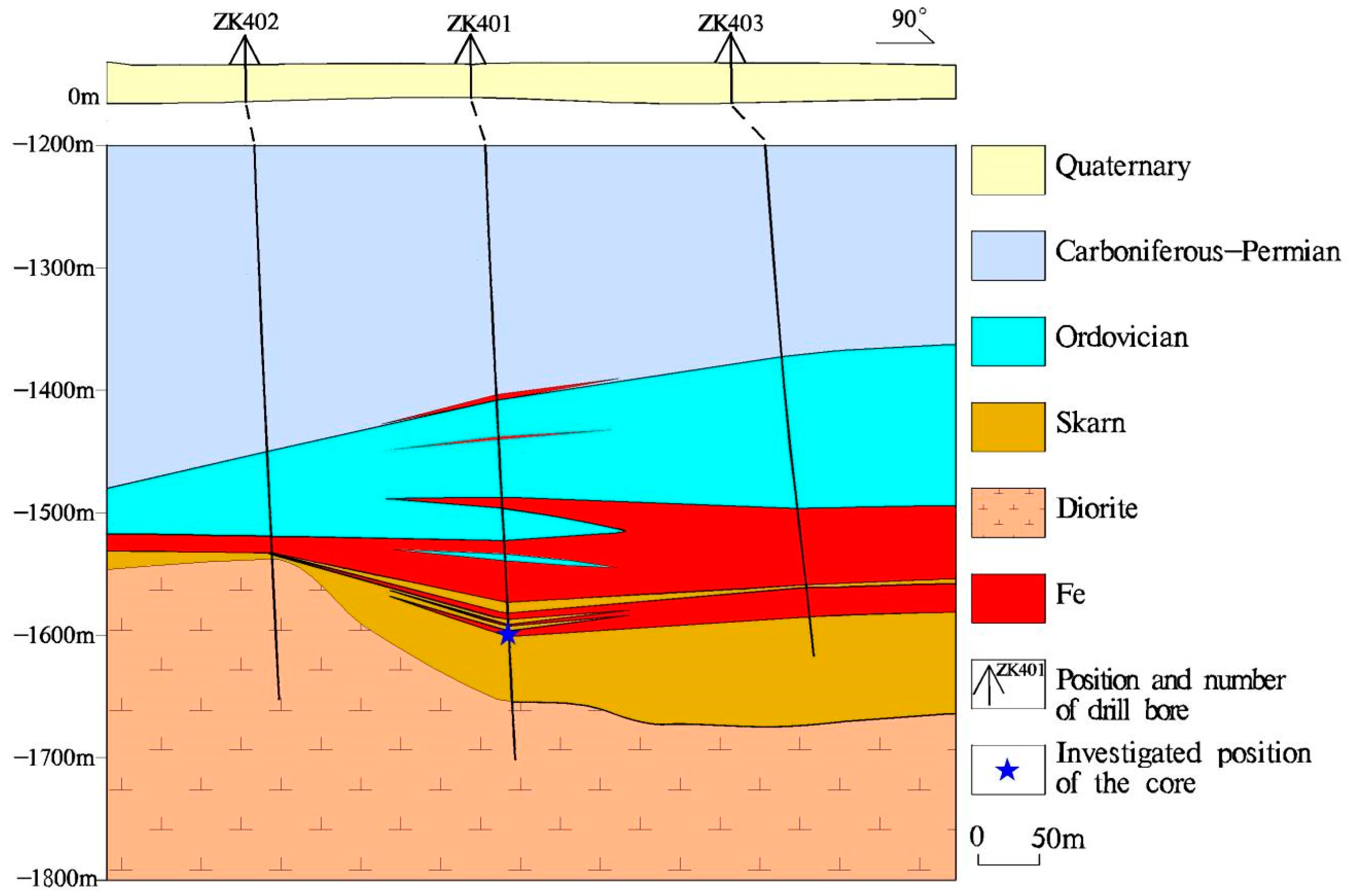
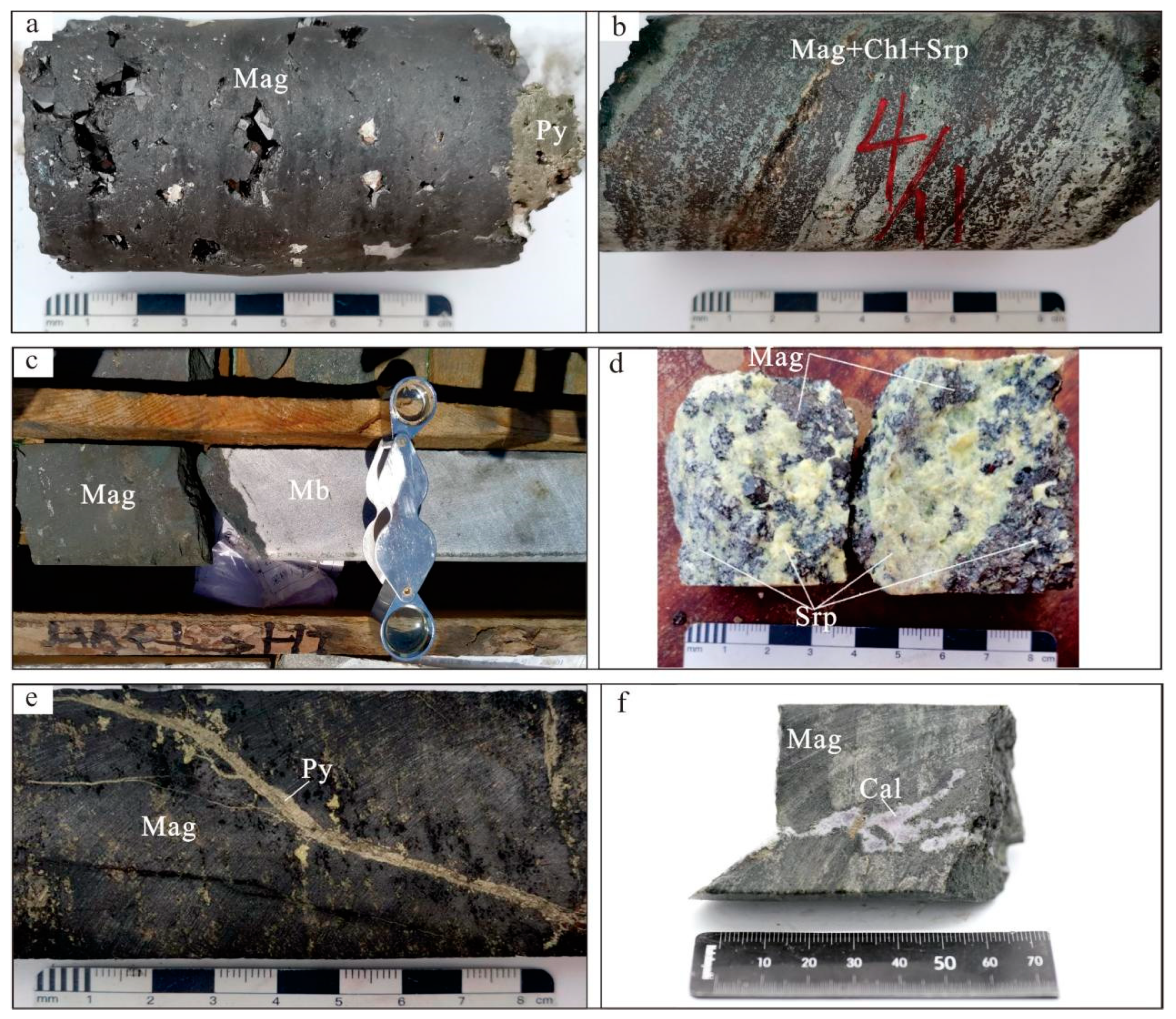
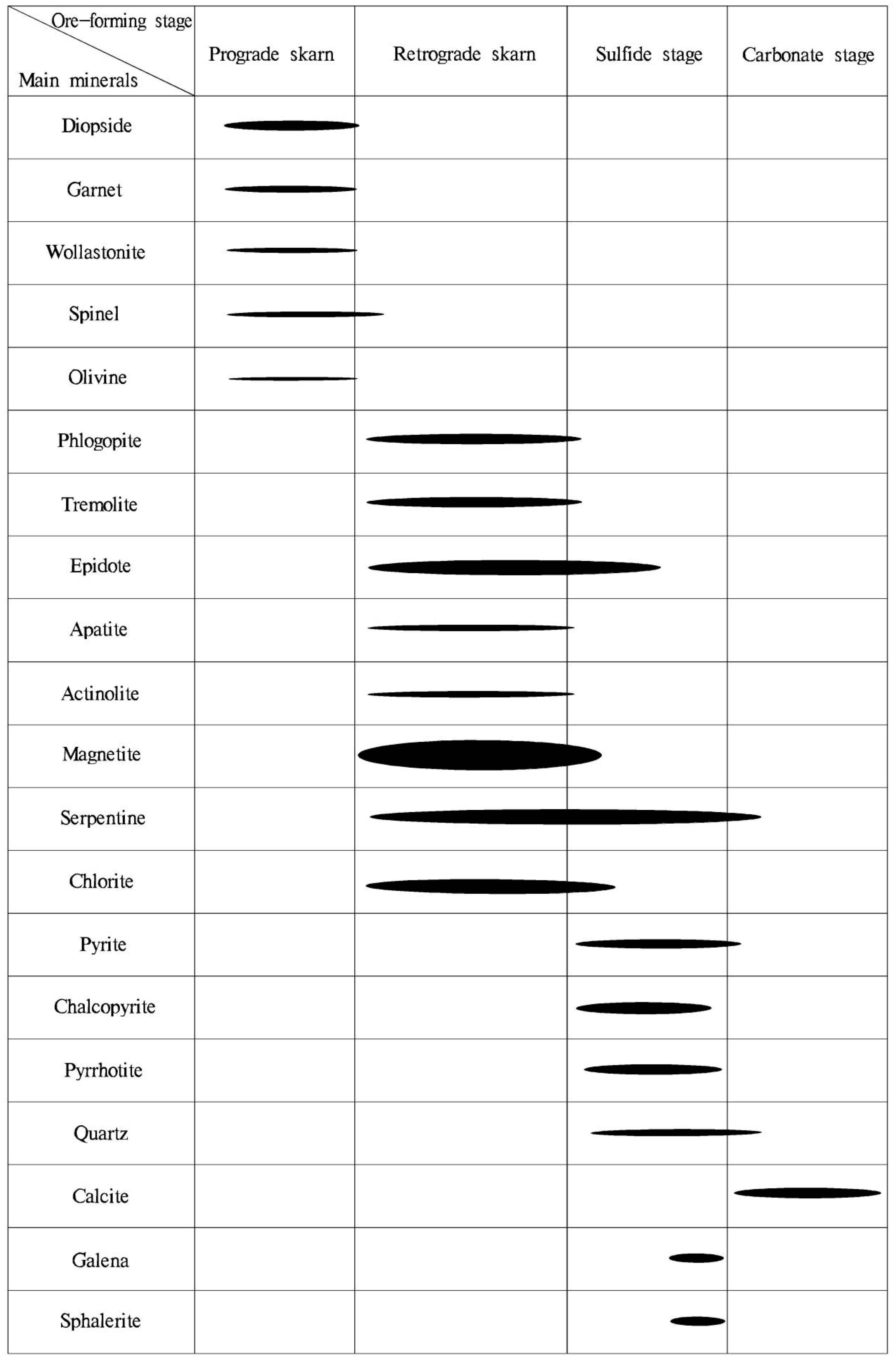
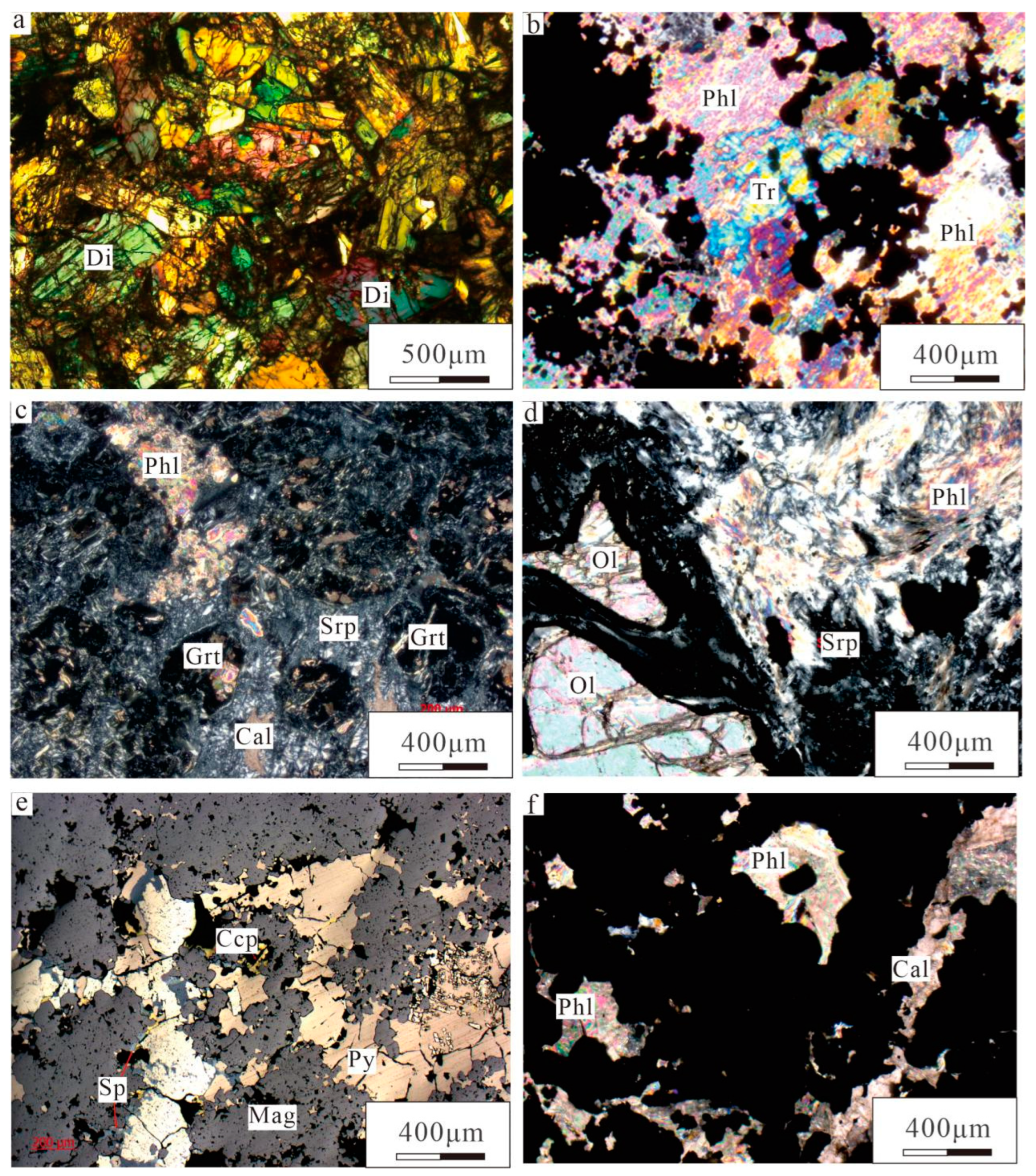
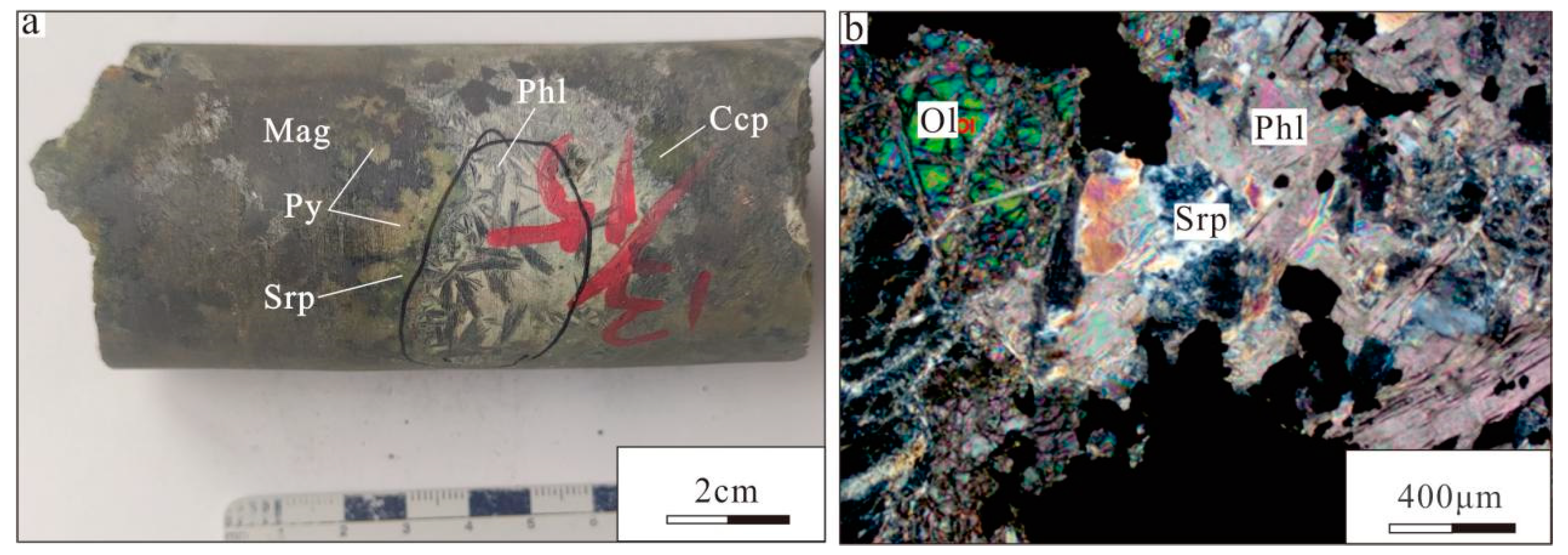
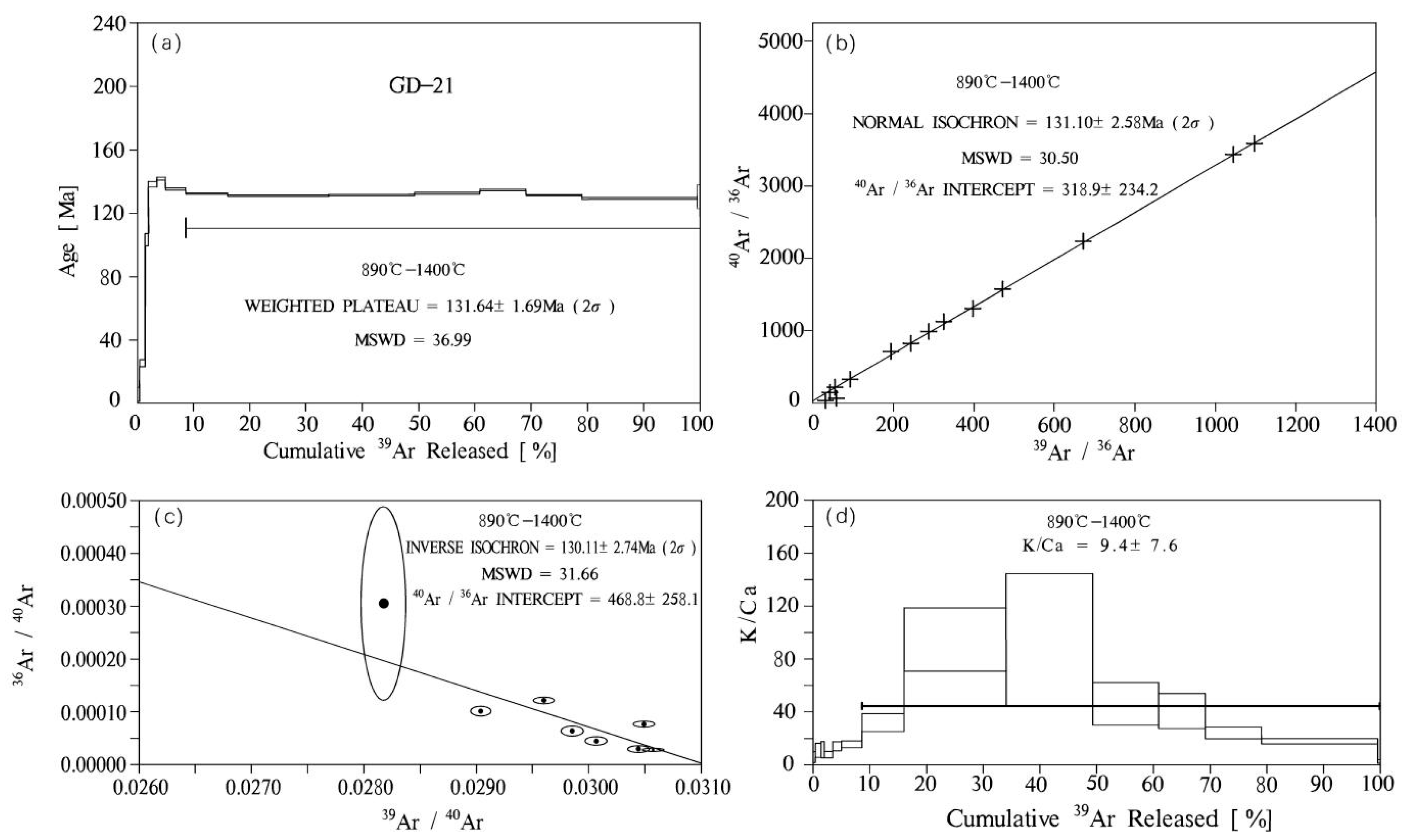
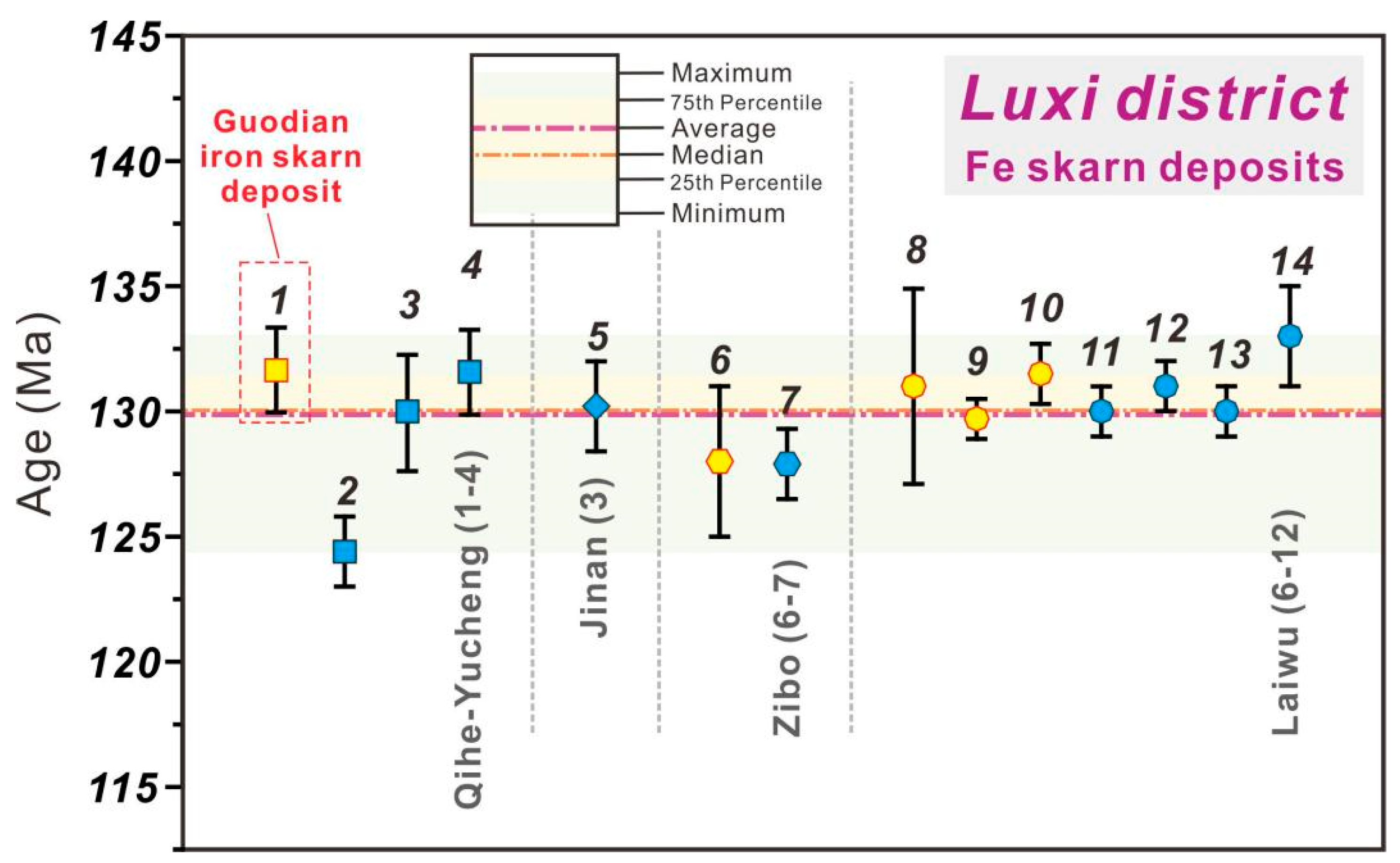
| Stage | Temperature (°C) | 36Ar [V] | 37Ar [V] | 38Ar [V] | 39Ar [V] | 40Ar [V] | 40(r)/39(k) | ±2σ | Age | ±2σ (Ma) |
| 1 | 650 | 0.0006111 | 0.0014474 | 0.0006399 | 0.0194853 | 0.20707 | 1.35719 | ±1.07573 | 5.67 | ±4.49 |
| 2 | 700 | 0.0008191 | 0.0018672 | 0.0014131 | 0.0479480 | 0.53465 | 6.09557 | ±0.51705 | 25.34 | ±2.13 |
| 3 | 740 | 0.0006790 | 0.0010850 | 0.0007522 | 0.0289415 | 0.93576 | 25.39494 | ±1.01684 | 103.31 | ±4.02 |
| 4 | 780 | 0.0012697 | 0.0038268 | 0.0019475 | 0.0698092 | 2.77303 | 34.34818 | ±0.47695 | 138.37 | ±1.85 |
| 5 | 820 | 0.0003878 | 0.0022915 | 0.0018773 | 0.0747677 | 2.74966 | 35.23811 | ±0.23765 | 141.82 | ±0.92 |
| 6 | 860 | 0.0005383 | 0.0048232 | 0.0042820 | 0.1746391 | 6.01760 | 33.54046 | ±0.18276 | 135.23 | ±0.71 |
| 7 | 890 | 0.0005312 | 0.0047771 | 0.0087042 | 0.3552671 | 11.82105 | 32.82266 | ±0.13381 | 132.44 | ±0.52 |
| 8 | 920 | 0.0007925 | 0.0039318 | 0.0208988 | 0.8652336 | 28.31166 | 32.43965 | ±0.10900 | 130.95 | ±0.42 |
| 9 | 950 | 0.0007064 | 0.0033577 | 0.0176964 | 0.7348026 | 24.14709 | 32.56683 | ±0.12146 | 131.45 | ±0.47 |
| 10 | 990 | 0.0011850 | 0.0051861 | 0.0137757 | 0.5563839 | 18.64310 | 32.86823 | ±0.14694 | 132.62 | ± 0.57 |
| 11 | 1030 | 0.0013723 | 0.0041595 | 0.0097853 | 0.3940666 | 13.57517 | 33.41007 | ±0.13906 | 134.73 | ± 0.54 |
| 12 | 1080 | 0.0019651 | 0.0084992 | 0.0119605 | 0.4784379 | 16.16810 | 32.57155 | ±0.12096 | 131.47 | ± 0.47 |
| 13 | 1200 | 0.0024833 | 0.0236282 | 0.0241768 | 0.9832604 | 32.25763 | 32.05353 | ±0.11515 | 129.45 | ± 0.45 |
| 14 | 1400 | 0.0002591 | 0.0039277 | 0.0006847 | 0.0238091 | 0.84498 | 32.29633 | ±1.94521 | 130.39 | ± 7.58 |
| Stage | Temperature (°C) | Time (days) | 40Ar(r) (%) | 39Ar(k) (%) | K/Ca | ±2σ | 40Ar/39Ar | 37Ar/39Ar | 36Ar/39Ar | 40Ar(moles) (×10−11) |
| 1 | 650 | 120.604 | 12.77 | 0.41 | 5.8 | ±4.2 | 10.6272 | 0.0743 | 0.0314 | 408.14 |
| 2 | 700 | 120.604 | 54.66 | 1.00 | 11.0 | ±5.3 | 11.1506 | 0.0389 | 0.0171 | 10.54 |
| 3 | 740 | 120.604 | 78.53 | 0.60 | 11.5 | ±6.2 | 32.3328 | 0.0375 | 0.0235 | 18.44 |
| 4 | 780 | 120.604 | 86.45 | 1.45 | 7.8 | ±2.4 | 39.7230 | 0.0548 | 0.0182 | 54.66 |
| 5 | 820 | 120.604 | 95.81 | 1.56 | 14.0 | ±3.4 | 36.7761 | 0.0306 | 0.0052 | 54.20 |
| 6 | 860 | 120.604 | 97.33 | 3.63 | 15.6 | ±2.5 | 34.4573 | 0.0276 | 0.0031 | 1.19 |
| 7 | 890 | 121.604 | 98.64 | 7.39 | 32.0 | ±6.8 | 33.2737 | 0.0134 | 0.0015 | 2.33 |
| 8 | 920 | 121.604 | 99.14 | 18.00 | 94.6 | ±23.9 | 32.7214 | 0.0045 | 0.0009 | 5.58 |
| 9 | 950 | 121.604 | 99.10 | 15.29 | 94.1 | ±50.0 | 32.8620 | 0.0046 | 0.0010 | 4.76 |
| 10 | 990 | 121.604 | 98.09 | 11.58 | 46.1 | ±16.1 | 33.5076 | 0.0093 | 0.0021 | 3.68 |
| 11 | 1030 | 121.604 | 96.98 | 8.20 | 40.7 | ±13.3 | 34.4489 | 0.0106 | 0.0035 | 2.68 |
| 12 | 1080 | 121.604 | 96.38 | 9.95 | 24.2 | ±4.5 | 33.7935 | 0.0178 | 0.0041 | 3.19 |
| 13 | 1200 | 121.604 | 97.70 | 20.45 | 17.9 | ±1.9 | 32.8068 | 0.0240 | 0.0025 | 6.36 |
| 14 | 1400 | 121.604 | 90.96 | 0.50 | 2.6 | ±1.3 | 35.4896 | 0.1650 | 0.0109 | 1.67 |
| Mine | Typical Deposit | Ore-Forming Intrusions | Ore-Controlling Strata | Ore-Controlling Structure | Orebody Space Occurrence | Wall Rock Alteration and Metamorphism | |
|---|---|---|---|---|---|---|---|
| Intrusions | Lithology | ||||||
| Qihe–Yucheng | Guodian | Pandian intrusion | Pyroxene diorite, diorite, | Ordovician dolomitic limestone, dolomite, Carboniferous–Permian sandstone and mudstone | The intersection of fault structures or the intersection of fault structures and the core of brachy anticline | Contact zone occurrence, interlayer filling, xenolith structure, fracture penetration | Skarnization, phlogopitization, serpentinization, sodium alteration, marblezation, keratinization |
| Litun | Litun intrusion | Pyroxene diorite, hornblende diorite, quartz diorite | Carboniferous–Permian Sand–mudstone | ||||
| Dazhang | Dazhang intrusion | Dioritic | Ordovician dolomitic limestone and limestone | ||||
| Zibo | Wang Wangzhuang | Jinling complex | Monzodiorite, hornblende diorite | Ordovician limestone and dolomitic limestone | Jinling brachy anticline | Contact zone occurrence | Potassic, sodium alteration, marblezation,skarnization |
| Laiwu | Zhang Jiawa | Kuangshan pluton | Pyroxene diorite, diorite, monzonite, monzodiorite | Ordovician dolomite and dolomitic limestone | Mine anticline and its secondary folds | Contact zone occurrence, interlayer filling, xenolith structure, fracture penetration | Skarnization, phlogopitization, serpentinization, chloritization |
Disclaimer/Publisher’s Note: The statements, opinions and data contained in all publications are solely those of the individual author(s) and contributor(s) and not of MDPI and/or the editor(s). MDPI and/or the editor(s) disclaim responsibility for any injury to people or property resulting from any ideas, methods, instructions or products referred to in the content. |
© 2024 by the authors. Licensee MDPI, Basel, Switzerland. This article is an open access article distributed under the terms and conditions of the Creative Commons Attribution (CC BY) license (https://creativecommons.org/licenses/by/4.0/).
Share and Cite
Feng, Q.; Gao, M.; Fu, C.; Li, S.; Li, Y.; Gao, J.; Ma, M.; Wang, Z.; Zhu, Y.; Wu, B.; et al. Phlogopite 40Ar/39Ar Geochronology for Guodian Skarn Fe Deposit in Qihe–Yucheng District, Luxi Block, North China Craton: A Link between Craton Destruction and Fe Mineralization. Minerals 2024, 14, 690. https://doi.org/10.3390/min14070690
Feng Q, Gao M, Fu C, Li S, Li Y, Gao J, Ma M, Wang Z, Zhu Y, Wu B, et al. Phlogopite 40Ar/39Ar Geochronology for Guodian Skarn Fe Deposit in Qihe–Yucheng District, Luxi Block, North China Craton: A Link between Craton Destruction and Fe Mineralization. Minerals. 2024; 14(7):690. https://doi.org/10.3390/min14070690
Chicago/Turabian StyleFeng, Qiwei, Mingbo Gao, Chao Fu, Siyuan Li, Yadong Li, Jilei Gao, Ming Ma, Zhaozhong Wang, Yidan Zhu, Binglu Wu, and et al. 2024. "Phlogopite 40Ar/39Ar Geochronology for Guodian Skarn Fe Deposit in Qihe–Yucheng District, Luxi Block, North China Craton: A Link between Craton Destruction and Fe Mineralization" Minerals 14, no. 7: 690. https://doi.org/10.3390/min14070690





